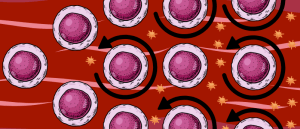Hunting zombie cells: novel technique for tagging senescent cells

Original story from Mayo Clinic (MN, USA).
A new technique for tagging senescent cells – which are associated with numerous diseases – has been developed.
When it comes to treating disease, one promising avenue is addressing the presence of senescent cells. These cells – also known as ‘zombie cells’ – stop dividing but don’t die off as cells typically do. They turn up in numerous diseases, including cancer and Alzheimer’s disease, and in the process of aging. While potential treatments aim to remove or repair the cells, one hurdle has been finding a way to identify them among healthy cells in living tissue.
Mayo Clinic (MN, USA) researchers have reported finding a new technique to tag senescent cells. The team used molecules known as aptamers – small segments of synthetic DNA that fold into three-dimensional shapes. Aptamers can attach themselves to proteins on the surfaces of cells. In mouse cells, the team found several rare aptamers, identified from among more than 100 trillion random DNA sequences, that can latch onto specific cell-surface proteins and flag senescent cells.
“This approach established the principle that aptamers are a technology that can be used to distinguish senescent cells from healthy ones,” shared biochemist and molecular biologist Jim Maher, a principal investigator of the study. “Though this study is a first step, the results suggest the approach could eventually apply to human cells.”
 Blood factor reverses aging in hematopoietic stem cells
Blood factor reverses aging in hematopoietic stem cells
Infusions of platelet factor 4 (PF4) have reversed aging in human hematopoietic stem cells (HSCs), the precursors of a range of blood and immune cells.
From a quirky idea to collaboration
The project began with the quirky idea of a Mayo Clinic graduate student who had a chance conversation with a classmate.
Keenan Pearson, who recently received his degree from Mayo Clinic Graduate School of Biomedical Sciences (MN, USA), was working under the mentorship of Maher, studying how aptamers might address neurodegenerative diseases or brain cancer.
A few floors away, Sarah Jachim, who was also then conducting her graduate research, was working in the lab of researcher Nathan LeBrasseur, who studies senescent cells and aging.
At a scientific event, the two happened to chat about their graduate thesis projects. Pearson thought aptamer technology might be able to identify senescent cells. “I thought the idea was a good one, but I didn’t know about the process of preparing senescent cells to test them, and that was Sarah’s expertise,” commented Pearson, who became lead author of the publication.
They pitched the idea to their mentors and to researcher Darren Baker, who investigates therapies to treat senescent cells. At first, Maher acknowledges, the students’ idea seemed “crazy” but worth pursuing. The three mentors were excited about the plan. “We frankly loved that it was the students’ idea and a real synergy of two research areas,” shared Maher.
The students obtained compelling results sooner than they expected and quickly recruited other student participants from the labs. Then-graduate students Brandon Wilbanks, Luis Prieto and Caroline Doherty each contributed additional approaches, including special microscopy techniques and more varied tissue samples. “It became encouraging to expend more effort,” Jachim expressed, “because we could tell it was a project that was going to succeed.”
Identifying attributes of senescent cells
The study has provided new information about senescent cells beyond a way to tag them. “To date, there aren’t universal markers that characterize senescent cells,” explained Maher. “Our study was set up to be open-ended about the target surface molecules on senescent cells. The beauty of this approach is that we let the aptamers choose the molecules to bind to.”
The study found several aptamers latched onto a variant of a specific molecule on the surface of mouse cells, a protein called fibronectin. The role of this variant fibronectin in senescence is not yet understood. The finding means that aptamers may be a tool to further define unique characteristics of senescent cells.
Additional studies will be necessary to find aptamers that can identify senescent cells in humans. Aptamers with the ability to latch onto senescent cells could potentially deliver a therapy directly to those cells. Pearson noted that aptamer technology is less expensive and more versatile than conventional antibodies, proteins that are typically used to differentiate cells from one another.
“This project demonstrated a novel concept,” concluded Maher. “Future studies may extend the approach to applications related to senescent cells in human disease.”
This article has been republished from the following materials. Material may have been edited for length and house style. For further information, please contact the cited source. Our press release publishing policy can be accessed here.